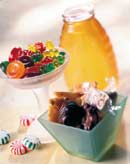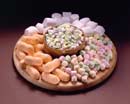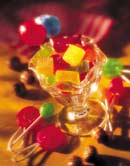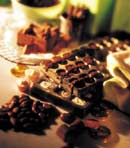The Wide World of Confections

By Paula Frank,
Technical Editor, Food Product Design

Many confections consumed today have been around for years. In fact, according to Concord Confections Inc., Concord, Ontario, Canada, producers of Dubble Bubble® bubble gum, scientists discovered a 9,000-year-old wad of gum in Sweden. Other ancient civilizations consumed confections made from ground nuts and honey, and the Aztecs reportedly made a concoction using cacao beans, which led to the discovery of chocolate as a delicacy. While many of these sweets evolved over the years, the confectionery process remained more an art than a science until the 20th century.
Sugar crystallization research helped expand the world of confections and lead to categorization based on crystalline and noncrystalline structures. Other factors, such as the addition of fats, dairy ingredients, stabilizers or whipping agents, influence not only finished-product texture, but flavor as well. Processing procedures are also critical in determining finished-product attributes. Although confectionery development remains an art to some degree, many scientific factors contribute to the candy's flavor, appearance and shelf stability.
The candy shop
Confections come in a variety of forms including hard candies, caramels, toffees, jellies, gummies, fudge, nougats, marshmallows, fondants, marzipan and other nut pastes and butters, pressed tablets, chocolates and compounds. Sometimes different components are blended into one item, such as the chocolate bar filled with caramel and nougat, cream-filled licorice or the chocolate or nut piece coated with a sugar-based candy shell.
Indulgent confections, such as truffles, also have grown in popularity in spite of health-conscious attitudes. In fact, recent reports of chocolate's beneficial antioxidant properties may even change consumer perception. While traditionally used as a coating for nuts, chocolate or compound now surrounds items such as dried fruit, soy nuts and sunflower seeds.
The market for sugar-free gum and tableted mints has increased, particularly in light of dental-care claims permitted for those made with polyols. Nutraceutical confections are also on the rise, such as calcium caramel chews and drops made with echinacea and/or vitamin C.
Sweet design
In confections, different ingredients alter both texture and flavor, ultimately yielding a visually appealing finished product with good texture, flavor and shelf stability. Sugar crystallization, or lack thereof, plays a large role in textural development and the confection's perceived quality. These diverse textures range from hard, to soft and creamy, to chewy.
Sucrose is key in the crystallization process, or graining. Cooling a supersaturated sucrose solution slowly without agitation forms large crystals. This is the basis of making rock candy. Both the degree and type of crystal formation depends on whether the supersaturated sucrose solution is agitated, and/or subjected to different temperatures and cooling rates. In addition, adding crystallization inhibitors, such as corn syrup or invert sugar, often controls the extent of graining. When sucrose is used as the sole sweetener, inversion (by lowering the pH with acid) might be required to help control graining.

The impact of temperature and agitation on sugar-crystal formation "depends on the product formulation," says Henry Non aka, manager, technical services, Corn Products International Inc., Bedford Park, IL. "Let's say you're limited in the type of agitation you can provide. In that case, the only variables you have to work with are the solids level of the formulation and the temperature. It's often trial and error to get to the point where you want the product to be. If you know you get a certain crystal structure at a particular temperature and agitation rate, and if you decrease agitation or increase temperature, the product becomes coarser. On the other hand, if you increase agitation and keep the temperature the same or decrease it, you get finer crystals. There are some limits, because if you go too low in temperature, there are other viscosity effects that give coarse crystals, so it's not completely linear across the range."
Corn syrup, produced from starch via acid hydrolysis or a combination of acid-enzyme hydrolysis, is available in a variety of DE values and degrees of polymerization. High-maltose corn syrups are made from starch that has been treated with a variety of enzymes. The enzyme combination used determines syrup functionality. "The enzyme technology that is used to produce today's specialty corn syrups gives product developers many new options," notes Jeff Bogusz, application specialist, Cerestar, a company of Eridania Béghin-Say, Hammond, IN. "By adjusting the saccharide profile, properties such as sweetness, water activity (Aw), freezing point, browning rate, texture and foaming stability can be manipulated.".
Honey not only sweetens confections, it adds a unique flavor plus functions as a crystallization inhibitor as a result of its composition. Predominant sugars are fructose at 38.5% and glucose at 31.0%. Its fructose content, which has a higher solubility index than sucrose, allows honey to solublize readily in a water/sucrose solution. In honey candies — where honey makes up at least 60% of the total sweetener blend — a seeding sugar, one that initiates crystallization, must be present in order for honey to crystallize, notes Marcia Cardetti, technical director, National Honey Board, Longmont, CO. Creamed honey or honey fondant may also be used to promote crystallization. Honey has many uses in confectionery development. The National Honey Board can provide additional information at www.nhb.org.
Polyols are becoming more prevalent in confections, due in part to an aging population's concern with diabetes, an interest in the sweeteners' noncariogenic or anticariogenic (as in the case of xylitol) properties, and lower caloric value, notes Ronald C. Deis, Ph.D., director, product and process development, SPI Polyols Inc., New Castle, DE. The product developer often chooses a polyol for its humectant property; the ability to function as a bulk sweetener or act as a carrier for flavors, colors and enzymes; and/or because it doesn't crystallize or contribute to Maillard browning. Maltitol, which is 90% as sweet as sucrose, is becoming more prevalent in compound coatings as a pound-for-pound sucrose replacement.
Each polyol, whether sorbitol, mannitol, xylitol, erythritol, maltitol, lactitol, isomalt or one of the hydrogenated starch hydrolysates (HSH), have unique properties: varying degrees of sweetness, solubility and negative heat of solution; and government approval dictating usage. Some have GRAS status, while others have food additive approval. The limiting factor for usage often results from polyols' laxation effect. For instance, mannitol use is limited by its low laxative threshold at 20 grams per day, says Deis. However, mannitol's insolubility makes it an effective dusting agent for chewing gum.
Tasty sweets
Flavoring confections plays a key role in consumer acceptance and requires skill on the part of the developer to balance flavor notes and timing release. Encapsulation is often used to control flavor delivery, such as providing a burst of concentrated sour flavor, explains Vernetta Dally, applications lab manager, Balchem Encapsulates, Slate Hill, NY.
In addition, encapsulated flavors become necessary when a flavoring ingredient may cause an adverse reaction with other ingredients or when other ingredients negatively impact the flavor. "Encapsulation prevents acid flavors from causing an acid-sugar reaction that may create sugar inversion," notes Dally. "In sour-flavored chewing gum, encapsulation protects the acids from texturizing ingredients such as calcium carbonate, which would otherwise buffer the acid, giving the gum a flat flavor." Release mechanisms for encapsulated flavors generally include chewing shear or temperature. "The only differences with the coating of our current acid flavors are the melting ranges that vary from 90°F to approximately 158°F, which may offer some processing advantages," says Dally.
Good communication between the flavor chemist and candy-product developer along with adequate shelf life and abuse testing helps protect against off-note development in finished confections. "A key factor is making sure the usage level is correct," says Cindy Cosmos, senior flavor chemist, Bell Flavors and Fragrances Inc., Northbrook, IL. "Sometimes comments of ‘too perfumey,' ‘chemical' and ‘burns the mouth' are good examples of excessive usage."
Other off-notes can develop during processing: losing volatiles can leave the flavor unbalanced, or chemical reactions can take place during specific processes. For example, "oxidation is a common occurrence with citrus flavors, sometimes creating a ‘pine-like' or ‘turpentine' note," explains Cosmos. "Maillard or acetyl reactions occurring in the flavor may increase ‘brown sugar' or ‘cooked' notes in chocolates and creams. Also, a rancid note can occur if the diluents in an oil-soluble flavor have gone bad, and ‘cheesy' or ‘sour' comments may be the result of acids in the flavor reacting with other components."
Ingredients such as vanilla and honey are used for their enhancement properties as well as their contribution to overall flavor perception. Lighter honeys, including the widely used clover honey, tend to be milder in flavor, while darker honeys, such as buckwheat, tend to be stronger in flavor. Thus, lighter honeys generally find more use in confectionery applications; however, use is application-specific.

Other sweetener choices can also impact flavor. "There has been a global trend in the last few years to replace sucrose with a high-maltose specialty syrup in confectionery applications," says Bogusz. "The primary driving factor is cost. High-maltose corn syrup is generally one-third to one-half as sweet as sucrose, which was originally perceived as a negative, but has actually shown to have a positive impact on flavor perception. A lower sweetness level makes flavors such as cinnamon, coffee, peanut butter and mint seem more natural. Less sweetness is rarely mentioned in consumer tests. Instead, the comments usually indicate more intense flavor and sour perception, and fewer off-notes."
The correct flavor form depends on the application. As Cosmos explains: "Oil-soluble, liquid flavors are preferable in confections containing fat, such as creams, fondant and compound coatings, so that the flavor can bind with the fat for a full flavor profile, and where processing temperatures reach 300°F, which includes hard candy and toffee. Water-soluble flavors that contain water can affect the moisture level of the candy and cause it to become tacky. Water-soluble flavors can also flash off if the diluent is alcohol and can create a potential fire-hazard. Panned confections, stick and bubble gums usually require both a liquid, oil-soluble flavor and a dry flavor since they can be added at different points of the manufacturing process." She recommends water-soluble flavors, either liquid or dry, for panned candies, gummies and jelly beans because these products involve lower processing temperatures. Tablets require flavors in dry form so they can be easily combined with the powder ingredients for a balanced flavor after compression.
Confections 101
Confections are often categorized according to their crystalline structure. The noncrystalline category includes hard candies, caramels, toffee, jellies and gummies, while the crystalline category includes chocolates, compound coatings, fudge, fondants and creams, nougats, marshmallows, panned candies, tablets and nut pastes. Each confection type is discussed briefly in the following sections. (For an in-depth look at chocolate and compound coating, see Indulgent Confections in the February 2000 issue of Food Product Design.)
Edible glass
Hard candy is actually an amorphous, noncrystalline form frequently called a glass. This type of candy contains flavors, colors and possibly acidulants in addition to its carbohydrates. These commonly include 50% to 70% sucrose and 30% to 50% 42 DE corn syrup, notes Robert Boutin, executive vice president, Knechtel Laboratories, division of Knechtel Research Sciences Inc., Skokie, IL.
Solubilizing sweeteners, typically under vacuum pressure, enables the supersaturated solution to boil at a lower temperature. Flavors and colors are then added to the cooled plastic mass, which is then formed into various shapes.
Achieving the correct moisture of less than 2% is critical in hard candies, because it influences stability. High moisture causes candy to become sticky or causes sucrose to recrystallize on the candy's surface. Storing in a humidity- and temperature-controlled environment, using proper packaging, adjusting the ratio of sucrose to corn syrup and completely solubilizing the carbohydrates during cooking helps prevent graining in the finished product. "The risk of crystallization can be reduced by using 36 DE corn syrup, which is a higher viscosity syrup than 42 DE, or by increasing the percentage of corn syrup used," explains Bogusz. "The downside of these options is that the viscosity of the molten candy increases dramatically. Subsequently, the candy is more difficult to pump, cook and form into finished product."
High-fructose corn syrups and 62 DE corn syrup give lower viscosity, but the high level of dextrose or fructose generate excessive browning, says Bogusz. "A variety of specialty high-maltose syrups can be used to produce hard candies with 40%, 20% or even 0% sucrose. Corn syrups produced with cocktails of various enzymes that manipulate the level of larger polysaccharides while keeping levels of dextrose low have a desirable working viscosity. The resulting candy has better clarity because sucrose will not crystallize and create a hazy product surface," he says.
For deposited hard candies, the story changes slightly, adds Bogusz. "High-maltose syrups are often used in these products to decrease browning rate and viscosity — a necessity for filling individual molds. One area often overlooked in the development of such products is the importance of the higher polysaccharides on shelf life. Without a sufficient amount of these long-chain sugars in the candy, it tends to liquefy."
Carmelized sweets
Caramels, although different in texture and moisture (10% to 12%) from hard candy, are manufactured similarly. The ratio of corn syrup to sucrose tends to be higher in caramels, which softens the texture. Fat in the form of butter or vegetable oil has a softening effect as well. "Gelatin is often used in caramels and other chews at the 0.25% to 1.00% level to add chewiness," notes Wayne A. Turner, technical director, Dynagel Inc., Calumet City, IL, and chairman of the Technical Committee for the Gelatin Manufacturers Institute of America. Gum arabic (acacia) helps prevent fat from separating and oxidizing on the confection's surface.
Caramels also contain dairy-based ingredients such as sweetened, condensed or evaporated milks, dried whey or cream. The dairy-based proteins react with the sugars during cooking and create the characteristic color and flavor associated with Maillard browning.
The cooking tempepature for caramels, approximately 250°F, is less than the roughly 300°F used for hard candy, because milk proteins have a tendency to burn. Toffee, while similar to caramels, contains lower levels of dairy and fat-based ingredients. It has a firmer texture as a result, and its cook temperature, 300°F, gives the confection more carmelization than caramels.
Gumming your food
Like caramels, gummy and jelly candies are characterized by their chewiness. Textures range from soft to hard, depending not only on the type of corn syrup used and the ratio of corn syrup to sucrose, but also on the type and amount of stabilizer used. Chewier candies tend to have a higher concentration of corn syrup in relation to sucrose. Also, the higher the syrup's DE, the softer the bite. Stabilizers such as starch, gelatin, gums and pectin provide a gel structure and contribute to properties such as shelf stability and flavor release. "Gelatin, in particular, plays an important role in flavor release, because its melting point is so close to human body temperature," notes Turner.
The Bloom value of gelatin refers to its gel strength. A higher Bloom value gives a firmer confection. "Gelatin does not require the use of any other food hydrocolloids; however, starches, gums or pectins are sometimes used in combination with gelatin to make the candy's texture a little shorter," says Turner.
Acid-thinned or thin-boiling starches can be used for jelly candies because they have a fluid hot viscosity for ease of mold depositing, yet form firmer gels upon cooling. "Sometimes a portion of the acid-thinned starch will be replaced with high-amylose starch, which is more linear in design, thus allowing tighter gels to form more quickly," explains Bogusz. "Including a portion of high-amylose starch in a formulation generally results in reduced processing time, lower production costs and creates a more ‘cheese-like' texture."
Moisture loss in jelly and gummy candies during shelf life causes product hardening, thus negatively impacting product quality. "This problem can be handled by replacing traditional corn syrup and most of the sugar with a specialty high-maltose, high-dextrose (HMHD) syrup that helps the candy retain its initial texture over extended periods," says Bogusz.
At times, gum arabic is used as a crystal inhibitor when the sucrose level in gummies is high. This gum has low viscosity and may be used as at levels as high as 40% in hard gumdrops, notes Boutin. (For more information on gum arabic, pectin and agar use in gummy candies, see Generating Yummy Gummies in the May 1998 issue of Food Product Design.)
Creamy centers
Fondants and creams are merely blends of a supersaturated solution of sucrose and corn syrup. The blend is boiled, cooled without agitation to 100°F, then recrystallized under agitation to less than 15 mm (0.0006 in.) and a moisture content of 12% to 13%, notes Boutin. While the terms fondant and cream are used interchangeably, fondant is generally firmer, while cream denotes softer blends. Finished product may be stored for several days and remelted for chocolate centers. As described earlier, temperature and agitation rate impact crystal size, and ultimately relative coarseness or smoothness of the finished product. Adding other ingredients such as butter, flavors, colors and/or nuts provides diversity.
Honey is a viable alternative for fondant or creams, but requires a seeding sugar or seed honey at about 10% for crystallization. As little as 1% crystallized honey may seed a batch if the fragments are finely ground. Honey with a moisture content averaging 17.5% to 18.0% produces a fondant with optimum consistency that is neither too hard nor too soft.
Fudge factor
Legend has it that fudge was discovered when someone accidentally grained a batch of caramel, inventing a confection that is a cross between caramel and fondant, explains Boutin. Today, fudge's texture varies from soft and paste-like to firm and short, depending on its sucrose to corn syrup ratio, as well as the degree and rate of crystallization.
Fudge may be produced either by a batch or a continuous process. Either process generally begins like that of caramel, but is then seeded with fondant. Other ingredients such as chocolate liqueur, flavors and nuts may be added at this stage as well.
Whip it …whip it good
Nougats and marshmallow incorporate a whipping or aerating agent into their formulations, which gives the confection a foamy texture. "Gelatin is irreplaceable to whipped confections, such as marshmallows, by lowering surface tension, and stabilizing and setting the foam via gelation," says Turner. "Cut, cast and extruded marshmallows are ordinarily made from gelatins in the 225 to 275 Bloom range. For instance, 250 Bloom is most commonly used at a rate of 1.7% to 2.5%. A grained marshmallow, which has a shorter texture than the more common elastic variety, traditionally uses gelatins in the 150 to 225 Bloom range."
Marshmallows, with a moisture content of 15% to 20%, "require a higher concentration of flavor, because the high moisture and occluded air dilute the taste impression," notes Boutin. Since marshmallows are susceptible to moisture loss, a humectant such as sorbitol may be used. On occasion, gum arabic, pectin or agar provide added stability.
Nougat, whether grained or chewy, varies in the ratio of sucrose to corn syrup. "The main difference is that chewy nougats will have about equal amounts of each, while grained (or short) nougats contain sucrose at approximately twice the level of corn syrup," explains Boutin. "Nougat is basically a mixture of fondant syrup and a frappé, which is a fondant syrup aerated with a whipping agent such as egg albumen or hydrolzyed soy protein. Finished moisture content for short nougat is approximately 9% to 11%, and 5% to 7% for the chewy type. Nougat often contains other ingredients such as vegetable fats, milk powder and nuts, which must be carefully blended in to avoid breaking the foam structure."
Pressed and formed
Tablets are pressed and formed into shape via high pressure. Formulations are generally dry compositions, although some chewier varieties may contain a small amount of hydrogenated oil, notes Nonaka. The sweetener compositions are typically "agglomerated forms of dextrose and sucrose where the particle size is increased to improve handling and flow for filling of a tableting press-die," he says.
Hydrogenated sweeteners such as sorbitol or xylitol are commonly used in sugarless tablets. Their use in breath mints is directly attributable to their negative heat of solution, which gives a cooling sensation. Pressed candy also contains flavors, color, and/or acidulants in addition to the sweetener blend, and may contain a release agent, such as magnesium or calcium stearate, to prevent sticking during compression, says Boutin.

Bursting your bubble
Chewing gum is an emulsion made of sweeteners including sucrose, corn syrup, dextrose, and for sugarless types, mannitol, sorbitol and xylitol; acidulants and/or flavors; possibly a plasticizer such as sorbitol and highly concentrated oil-based flavors; glycerin as a humectant; and a gum base. "Generally, the major ingredients in gum bases are latex rubbers at 10% to 20% (higher levels for bubble gum to allow for stretching and bubble forming); fillers or texturizers — either talc or calcium carbonate at 30% to 60%; softeners and plasticizers (fats and waxes) at 10% to 20%; and other incidentals at less than 10%. Most gum bases also contain BHA and BHT as stabilizer/ antioxidants," explains Boutin.
The ingredient addition sequence is critical to chewing gum's finished product characteristics and is generally done in stages beginning with the mixing and softening of the gum base followed by additions of sugar and finally the flavor. "The finished gum, which looks similar to stiff cookie dough, is then removed from the mixer and allowed to cool slightly before forming and sheeting," says Boutin. "A final conditioning step under controlled temperature and humidity of 80°F and 40% to 50% relative humidity (RH) is required to develop the desired chewing qualities and shelf life. This step can take a few minutes to eight to 12 hours depending on the finished product characteristics desired."
Panning pandemonium Panning describes the process used for layering coating on confections. Soft panning alternates layers of an adhesive syrup (e.g., corn syrup, gum arabic, and/or sucrose) with dry sucrose until the targeted piece size is reached. Starch-based jelly-bean centers are coated in this fashion. Flavoring and color are actually added to the outer layer with a finishing syrup.
Hard panning involves layering with liquid corn syrup followed by air-drying. "If the air is cold, the process is called cold panning; if hot, it is termed hot panning," says Boutin. "The result of hot-panning techniques is a continuum of thin layers of fine sucrose crystals that are extremely smooth and crisp. Jordan almonds are a typical example."
Sometimes, panning begins with a tiny seed coated with alternating layers of syrup and dextrose. For example, to make a jawbreaker with multiple flavor layers, a flavor can be added to the syrup and another to the dextrose. Once a layer dries, the flavor stabilizes within it, notes Cosmos.
A polishing or finishing step is often the final phase in the panning process. Depending on the confection, the outside coating may consist of aqueous wax, oil, oil-in-water emulsion, shellac or blend of wax and fat. "A product that's used on some candies to obtain greater water resistance is zein, a water-insoluble corn protein applied via a solvent such as isopropanol," says Nonaka. Many of these coatings not only improve surface appearance, but act as moisture barriers as well.
Going nuts
Many confections would be incomplete without nuts, which not only complement flavor but often add a contrasting texture as well. Although the type of nut used depends on personal taste preference, the choice may be a point of differentiation among competitors, particularly when high-valued varieties such as macadamias, almonds or pistachios are used.
Whether nuts are used raw, roasted or blanched in confections depends on the flavor and appearance the developer desires. "Blanching removes the skin," says Sam Cunningham, Ph.D., director of R&D, Blue Diamond Growers, Sacramento, CA. "There's no reason to blanch other than for cosmetic reasons. For instance, the flavor and texture of blanched vs. raw almonds are pretty similar."
Raw nuts generally are more stable than roasted nuts, but even so, a raw nut's shelf life is more than adequate to deliver a commercial product, explains Cunningham. "The choice to roast nuts for confectionery products is for flavor and texture. If you use a raw nut that is unroasted, it would be just fine also, but may not have as crisp of a texture nor quite the same pronounced roasted flavor," he says.
The European delicacy, marzipan, an almond paste, can be moulded or enrobed with chocolate. Almonds used in marzipan are blanched and roasted. The ground nuts are cooked down to a moisture of 15% to 17% (roasted almonds are 1.5% to 3.0% moisture, which demonstrates the vast difference in finished moisture between roasted nuts vs. ground nuts used in almond paste) and combined with sugar. "The ratio of almond to sugar may vary according to finished product use. A very high-quality confectionery center would have a higher almond content, whereas a moulded marzipan piece may have a higher sugar to almond ratio, although almond content would still be at least 35% of the total formulation," says Cunningham.
Confections can contain nut pastes made from other varieties of nuts. These pastes incorporate sucrose, corn syrup and a functional binder, such as gelatin or gum, in addition to ground nuts. The binder helps stabilize the fat and prevents oil migration.
 Nuts also add value to confections from a nutritional standpoint. "Almonds are loaded with vitamin E as well as polyphenolic compounds that are powerful antioxidants," says Cunningham. Although nuts are high in fat, the majority is monounsaturated, particularly in varieties such as almonds, Brazil nuts, hazelnuts, macadamia nuts, pecans, pistachios and walnuts. Research conducted on the health benefits associated with nut consumption suggests that plant sterols in pecans have cholesterol–lowering ability, and that walnuts' omega-3 fatty-acid content has a positive impact on coronary heart-disease prevention and on the treatment of other debilitating diseases.
Nuts also add value to confections from a nutritional standpoint. "Almonds are loaded with vitamin E as well as polyphenolic compounds that are powerful antioxidants," says Cunningham. Although nuts are high in fat, the majority is monounsaturated, particularly in varieties such as almonds, Brazil nuts, hazelnuts, macadamia nuts, pecans, pistachios and walnuts. Research conducted on the health benefits associated with nut consumption suggests that plant sterols in pecans have cholesterol–lowering ability, and that walnuts' omega-3 fatty-acid content has a positive impact on coronary heart-disease prevention and on the treatment of other debilitating diseases.
The wide world of confections offers much flavor and texture diversity simply by manipulating ratios and sweetener types; adding foaming agents or stabilizers; and through creative flavor and color development. The sky's the limit when it comes to creative development for children and adults alike. Just watch where you consume your creations. After all, chewing gum is illegal in Singapore.
• Photo: National Honey Board
• Photo: Dynagel, Inc.
• Photo: Corn Products International
• Photo: Balchem Encapsulates
• Photo: Corn Products International
© 2001 by Weeks Publishing Company
Weeks Publishing Company
3400 Dundee Rd. Suite #100
Northbrook, IL 60062
Phone: 847-559-0385
Fax: 847-559-0389
Used by permission from Food Product Design Magazine
SOURCE: Food Product Design Magazine
